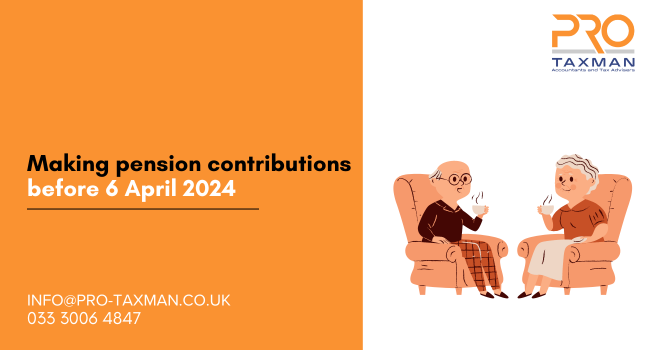As the end of the tax year approaches, it is prudent to review your pension contributions for the year and consider whether it is worth making further contributions before 6 April 2024. Remember, any annual allowances brought forward from 2020/21will be lost if not used by this date.
The amount of tax-relieved contributions that can be made in any tax year to a registered pension scheme is limited by both your earnings and your available annual allowances.
Earnings cap
Tax-relieved personal contributions to a registered pension scheme are capped at 100% of earnings for the year or, if higher, £3,600 (gross). This can be limiting for company directors who extract the majority of their profits as dividends, as dividends do not count as earnings for these purposes. However, contributions made by an employer (including those by the director’s personal or family company) are not limited by the earnings cap and can be taxefficient.
Annual allowance
The second limit on tax-relieved pension contribution is the annual allowance. Both individual and employer contributions count towards the allowance.
The allowance is set at £60,000 for 2023/24. However, where both threshold income (broadly income excluding pension contributions) exceeds £200,000 and adjusted net income (broadly income including pension contribution) exceeds £260,000, the allowance is reduced by £1 for every £2 by which adjusted net income exceeds £260,000 until the allowance reaches £10,000.
Where the allowance is not used in full in a tax year, it can be carried forward for three years. However, allowances from an earlier year can only be used where the current year’s annual allowance has been used in full. Allowances not used within this timeframe are lost. If you have made contributions to the level of your annual allowance for 2023/24, further contributions can be made to utilise any unused allowances from 2020/21, 2021/22 and 2022/23. The unused allowances for an earlier year are used before those of a later year.
The annual allowance for 2020/21 to 2022/23 inclusive was set at £40,000; threshold income was £200,000; the adjusted net income abatement threshold was £240,000 and the minimum allowance for the year was £4,000. It is important that the correct figures are used when calculating allowances available from earlier years.
Where a pension has been flexibly accessed by a contributor who has reached age 55, a reduced annual allowance applies to prevent recycling of contributions to benefit from further tax relief. This allowance (the money purchase annual allowance) is set at £10,000 for 2023/24. It was £4,000 for 2020/21 to 2022/23 inclusive.
If tax-relieved contributions are made in excess of the available annual allowance, the excess tax relief not due is clawed back by means of an annual allowance charge.
No lifetime allowance charges
The abolition of the lifetime allowance charge from 6 April 2023 (and the lifetime allowance itself from 6 April 2024) provide an opportunity for those whose tax-relieved pension savings have already reached £1,073,100 to make further contributions without incurring a punitive tax charge. However, where pension savings exceed £1,073,100 when accessed, the tax-free lump sum is capped at £268,275 (being 25% of this figure).
Take advice
In deciding whether to make further pension contribution before the end of the tax year, it is advisable to take financial advice.
Need professional accounting service or tax advice? Contact us to book a 15-min Free Consultation with us today.
To find out more please follow us on Facebook, Twitter, or LinkedIn. Feel free to contact us on 0333 006 4847 or request a call back by texting 075 6464 7474

